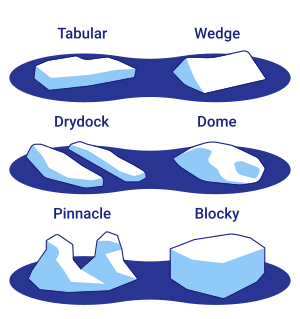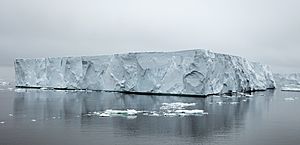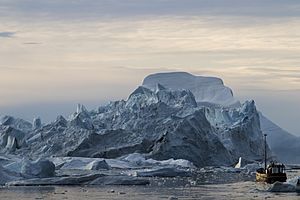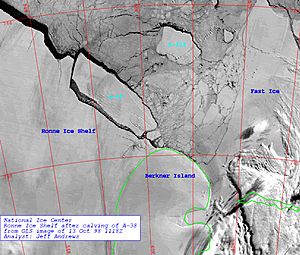Iceberg facts for kids
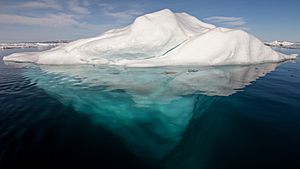
An iceberg is a huge piece of freshwater ice that has broken off a glacier or an ice shelf. These giant chunks of ice float freely in the ocean. To be called an iceberg, it must be more than 15 meters (about 50 feet) long. Smaller pieces are known as "growlers" or "bergy bits."
One famous event involving an iceberg was the sinking of the Titanic ship in 1912. This disaster led to the creation of the International Ice Patrol in 1914, which helps track icebergs to keep ships safe. Most of an iceberg is hidden underwater, which is why we have the saying "tip of the iceberg." It means that what you see is only a small part of a much bigger issue. Icebergs can be very dangerous for ships.
Icebergs come in many different sizes and shapes. Those that break off from glaciers in Greenland often have irregular shapes. However, icebergs from Antarctica's ice shelves are usually large and flat, like a tabletop. The biggest iceberg recorded recently was named Iceberg B-15. In 2000, it was nearly 300 kilometers (186 miles) long and 40 kilometers (25 miles) wide. The largest iceberg ever seen was in 1956. It was bigger than the country of Belgium!
Contents
Where the Word Comes From
The word iceberg comes from the Dutch word ijsberg. This word literally means "ice mountain." You can find similar words in other languages like Danish (isbjerg), German (Eisberg), and Swedish (isberg).
What Icebergs Are Like
Only about one-tenth (10%) of an iceberg's total size is visible above the water. This is because of Archimedes's Principle, which explains why things float. Pure ice is less dense than seawater, so most of the iceberg stays below the surface. It can be very hard to guess the shape of the underwater part just by looking at what's above.
Here's how icebergs are often classified by their size:
| Size Class | Height (meters) | Length (meters) |
|---|---|---|
| Growler | Less than 1 | Less than 5 |
| Bergy bit | 1 to 5 | 5 to 15 |
| Small | 5 to 15 | 15 to 60 |
| Medium | 15 to 45 | 60 to 122 |
| Large | 45 to 75 | 122 to 213 |
| Very large | More than 75 | More than 213 |
The biggest icebergs ever recorded have broken off from the Ross Ice Shelf in Antarctica. Some icebergs can be over 100 meters (328 feet) tall above the sea. They can weigh from 100,000 tonnes to over 10 million tonnes! The largest iceberg seen in the North Atlantic was 168 meters (551 feet) tall, which is like a 55-story building. These huge icebergs come from glaciers in western Greenland. Their inside temperature can be as cold as -15 to -20 degrees Celsius (5 to -4 degrees Fahrenheit).
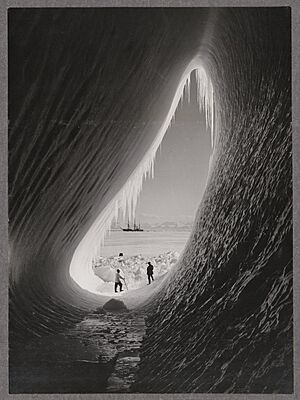
Iceberg Stability
An iceberg can suddenly flip over, or capsize, as it melts and breaks apart. This changes its center of gravity. Icebergs are unpredictable and can flip at any time without warning. When very large icebergs break off a glacier and flip, they can even push the entire glacier backward for a few minutes. This can cause earthquakes as powerful as an atomic bomb!
Iceberg Colors
Icebergs are usually white because they are covered in snow. But they can also be green, blue, yellow, black, striped, or even rainbow-colored! The color depends on things like seawater, tiny plants called algae, and how many air bubbles are trapped in the ice. If there's a lot of dirt or sediment in the ice, it can make the iceberg look dirty black.
Iceberg Shapes
Icebergs are classified by their shapes. The two main types are tabular and non-tabular.

- Tabular icebergs have steep sides and a flat top, like a giant table or a plateau. Their length is usually more than five times their height. These are also called ice islands and can be very large, like Pobeda Ice Island. Most tabular icebergs form when large pieces break off from ice shelves in Antarctica, such as the Ross Ice Shelf. The biggest icebergs in the world are formed this way.
Non-tabular icebergs have many different shapes, including:
- Dome: An iceberg with a rounded top.
- Pinnacle: An iceberg with one or more tall, pointed spires.
- Wedge: An iceberg with a steep side on one end and a gentle slope on the other.
- Dry-dock: An iceberg that has eroded to form a slot or channel through it.
- Blocky: An iceberg with steep, straight sides and a flat top. It looks like a block, not a flat sheet.
Tracking Icebergs
History of Tracking
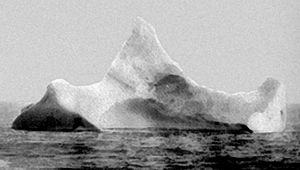
Before 1914, there was no system to track icebergs. This meant ships were at risk of hitting them. Even though many ships had sunk because of icebergs, it wasn't until the sinking of the Titanic in April 1912 that things changed. The Titanic was thought to be "unsinkable," but it hit an iceberg and sank, killing 1,496 people.
After this disaster, the United States Navy started patrolling the waters to watch for ice. In 1913, countries met in London to create a permanent system. This led to the formation of the International Ice Patrol (IIP). The IIP's job was to collect information about weather and oceans to track currents, ice movement, and ocean temperatures. They focused on the iceberg dangers near the Grand Banks and shared this information with ships.
Modern Tracking
Today, iceberg locations and sizes are tracked worldwide by the U.S. National Ice Center (NIC), which started in 1995. They use information from satellites orbiting the Earth to create maps and forecasts of ice conditions in the Arctic, Antarctic, and other areas.
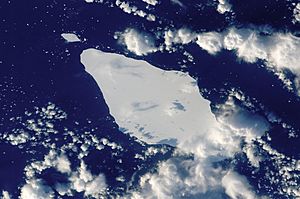
The NIC is the only group that names and tracks all icebergs in Antarctica. They give each iceberg larger than 10 nautical miles (18.5 km) a name. The name includes a letter showing where it came from and a number.
- A – From 0° to 90° West longitude (like the Weddell Sea)
- B – From 90° West to 180° longitude (like the Ross Sea)
- C – From 90° East to 180° longitude (like Wilkes Land)
- D – From 0° to 90° East longitude (like the Amery Ice Shelf)
The Danish Meteorological Institute also tracks icebergs around Greenland using satellite data.
Managing Icebergs
In places like Labrador and Newfoundland, Canada, special plans are made to protect offshore oil platforms from hitting icebergs.
Commercial Uses of Icebergs
Some companies have explored using iceberg water for products. For example, a business in the UAE once wanted to tow an iceberg from Antarctica to the Middle East, but it was too expensive. A German company, Polewater, also plans to tow Antarctic icebergs to places like South Africa.
Iceberg water is used in some products like bottled water, special ice cubes, and even alcoholic drinks. For instance, Iceberg Beer from Quidi Vidi Brewing Company is made with water from icebergs found near St. John's, Newfoundland. Even though Newfoundland and Labrador have more iceberg water than the entire United States uses in a year, the province added a tax on iceberg harvesting and limited how much freshwater can be exported.
Icebergs and the Ocean
When icebergs melt, they release fresh water into the ocean. This fresh water is lighter than the salty seawater, so it rises to the surface. Icebergs can also act like floating walls, called breakwaters, which can affect ocean waves.
Icebergs also contain different amounts of nutrients and minerals. When they melt, these are released into the ocean. The nutrients, especially iron from sediments, can help tiny ocean plants called phytoplankton grow. However, the amount of iron in icebergs can vary a lot depending on where they come from. This makes it tricky to know exactly how much icebergs affect ocean life.
Recent Large Icebergs
Here are some of the largest icebergs recorded in recent times:
- Iceberg B-15 broke off the Ross Ice Shelf in 2000. It was initially 11,000 square kilometers (4,200 sq mi) in size. The largest part, Iceberg B-15A, was still the biggest iceberg on Earth until it broke apart in 2005.
- 1987: Iceberg B-9, 5,390 square kilometers (2,080 sq mi).
- 1998: Iceberg A-38, about 6,900 square kilometers (2,700 sq mi).
- 1999: Iceberg B-17B, 140 square kilometers (54 sq mi). A shipping warning was issued for it in 2009.
- 2000: Iceberg B-15, 11,000 square kilometers (4,200 sq mi).
- 2002: Iceberg C-19, 5,500 square kilometers (2,100 sq mi).
- 2002: Iceberg B-22, 5,490 square kilometers (2,120 sq mi).
- 2003: Iceberg B-15A, 3,100 square kilometers (1,200 sq mi), broke off from B-15.
- 2006: Iceberg D-16, 120 square miles (310 km2).
- 2010: An ice sheet 100 square miles (260 km2) broke off the Petermann Glacier in Greenland. It was the largest Arctic iceberg since 1962.
- 2014: Iceberg B-31, 615 square kilometers (237 sq mi).
- 2017: Iceberg A-68, 5,800 square kilometers (2,200 sq mi), from the Larsen C ice shelf.
- 2018: Iceberg B-46, 225 square kilometers (87 sq mi).
- 2019: Iceberg D-28, 1,636 square kilometers (632 sq mi).
- 2021: Iceberg A-74 from the Brunt Ice Shelf, 1,270 square kilometers (490 sq mi).
- 2021: Iceberg A-76 from the Ronne Ice Shelf, 4,320 square kilometers (1,670 sq mi).
See also
 In Spanish: Iceberg para niños
In Spanish: Iceberg para niños



